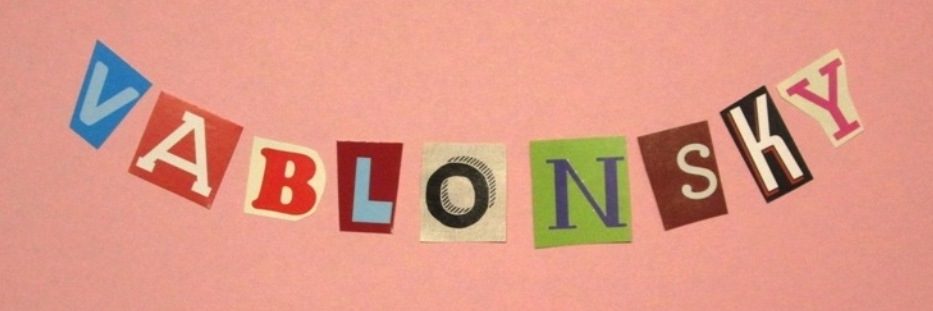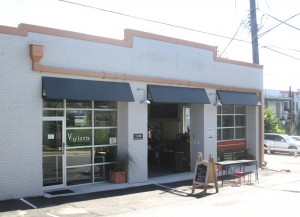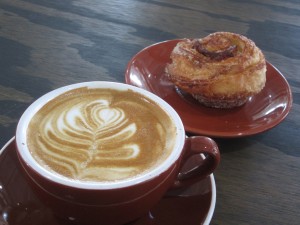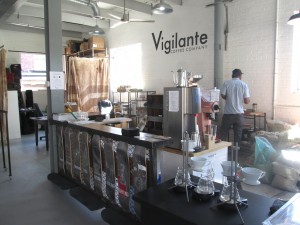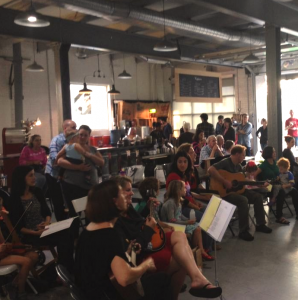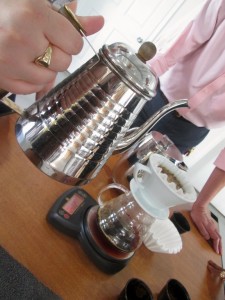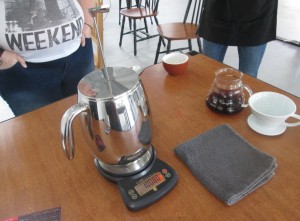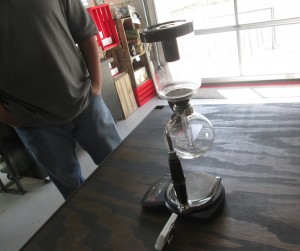(by Corbo Eng)
A vigilante may, certainly, take matters into his own hands. But, the motivating factor, invariably stemming from the inadequacy of his environment—where law enforcement may be inept or, in the present case, where the nascent coffee scene needs as many champions as it can get—the vigilantism is justified, even welcomed. Indeed, somebody has to lay down the law.
Frankly, who would be better than Chris Vigilante to do so? As the roast master and namesake behind Vigilante Coffee Company, he has been, surely, principled in building his brand. Beginning in 2011, after getting his start in Hawaii, where he learned the ropes and worked for a time on a coffee farm, Vigilante has gone from roasting beans in the basement of this row house in DC, incrementally growing his wholesale business, presiding over a series of pop-up coffee shops in town—at Mr. Yogato in Dupont Circle, Biergarten Haus on H Street, and the now shuttered Hogo near Mt. Vernon Square—selling coffee at the Eastern Market Flea, to opening his own roastery and café in Hyattsville in a former automobile showroom near the center of town. It’s been a whirlwind affair.
The only blip in this rapid enforcement has been the delayed opening of the much anticipated Maketto marketplace where Erik Bruner-Yang, Will Sharp, and Erica Skolnik (of Toki Underground, Durkl, and Frenchies fame, respectively) plan to open a new restaurant, a retail store, and a bakery/café and where Vigilante, onboard from the outset of the project, plans to set up shop with a coffee bar on the second floor. It’ll be a great place to start the day off or get a finishing cup of coffee after chowing down on one of Maketto’s Cambodian sandwiches. The market, which was supposed to have a February 2012 opening, now, should open, according to Vigilante, late this year or early next year. Let’s keep our fingers crossed.
In the meantime, the roastery and café in Hyattsville, which has become a de facto headquarters and home base, is Vigilante’s pride and joy. One side of the vast space—no doubt, dearest to Vigilante’s heart—to the right of the entrance, has been set aside for roasting and production with the front counter adjacent to it. A case of Frenchie’s baked goods, including their famed croissants and cinnamon rolls, and bags of Vigilante’s ground coffee (with that familiar Abe Lincoln logo) are on display; and, an espresso machine is at the ready.
The rest of the shop is spartanly decked out with a few tables and some spare counter seating. It’s the kind of space that, while not exactly inhospitable, doesn’t offer the cozy confines of a smaller coffee shop. The fact that salesmen once sold Model T Fords here isn’t hard to imagine. However, the spacious roastery and café excels in another way—one that takes advantage of its open interior: to be a community gathering place. Vigilante’s motto is “Where Coffee Meets Community.” In that vein, Vigilante hosted his first “alley jam” on September 13th where the public came to hear local musicians showcase their music.
However, Vigilante, mindful of his own journey and his formative days in the Hawaiian coffee fields, wants, as well, to pay it forward. Besides being a roastery and café, the Hyattsville property was also conceived as a “coffee lab,” a place where Chris Vigilante can realize his objective to train the community: wholesale customers and burgeoning entrepreneurs—on how to launch and operate a business. The general public isn’t left out. As a tie-in to his single-origin coffee cuppings on Saturday mornings, just a few weeks after the first alley jam, Vigilante offered his Brewing 101 class where participants, as the name of the class suggests, were taught the basics of brewing a good cup of coffee.
That class, meeting on a warm Saturday afternoon and consisting of an eclectic mix of baristas-in-the-making, ardent home brewers, and novices boasted about 12 students—including myself. After we were presented a brief overview and history of the three brew methods that we were to learn (pour-over, French press, and coffee siphon), the class was divided into groups of three and assigned to separate tables with the necessary accoutrements to try out the various methods. Guided by Vigilante and by Ashley, a back of house staffer who was assisting him, class members, in turn, first attempted to make the perfect pour-over cup. This required pouring hot water from a sleek Kalita pour-over kettle onto grounds resting in a Kalita Wave Dripper while using just the right flow rate and swirling motion. The target was to add 400 grams of water (at about 212 degrees) to 28 grams of coffee grounds.
“Watch for the bloom,” Vigilante said as he made sure that the distinctive bulging action occurred as the grounds became inundated with hot water and began releasing carbon dioxide. “Wait for about 45 seconds. Then, pour more water,” he instructed. “Hit the center. Don’t pour the water onto the folds of the filter. You want the filter to retain its wavy shape.”
With each completed attempt, the students in each group tried each other’s handiwork—and, even that of the participants at the other tables. Coffee poured freely as we savored the floral, chocolatety, or pungent flavors from Nicaraguan, Honduran, and Ethiopian beans. By the time the class had moved on to the next method—French press—and had lowered the plunger on the corresponding coffee pot to trap the coarse grounds at the bottom of the decanter, there was another round of brews to try—this time from a process that didn’t employ a paper filter. The end product was thicker, fuller, and oiler. “I like the taste of the oils,” I said as Vigilante asked for our opinions.
For the final act, Vigilante gathered the class at a table near the front of the building and stood over a two chambered contraption—one with a bulbous glass beaker set over a small butane burner. It was a set-up that looked more like something Bill Nye the Science Guy would have used to boil acid or mix chemicals than a barista would employ to make something to drink; but, as truth would have it, its intended purpose was to make coffee. “This is a siphon,” Vigilante said, looking proud and confident. “It’s a brewing method that uses vapor pressure.”
Most of us, impressed by the mad scientist contraption, which we later learned was a Hario TCA-5 siphon, and, perhaps, half-expecting an explosion to take place, nodded and watched as Vigilante lit the burner and set the water in the lower chamber to a boil. We stared with rapt attention as the pressure in the lower beaker pushed the water into the cylinder above it, almost as if it had been sucked up by a sea serpent, where Vigilante, then, tossed in the coffee grounds and agitated the water slightly. Once the grounds were allowed to brew, the burner was turned off, and the lower beaker cooled, the auburn-colored brew descended into the lower chamber—ready to be enjoyed, which we did even though we were pretty caffeinated by now and ready to do the Twist like Chubby Checker.
“When Maketto opens, I’m going to have a siphon bar there,” Vigilante explained to me. I thought to myself, “It’s going to be a stunning way to make coffee.” Each participant received a gift bag before leaving—which was highlighted by a 6 ½ ounce bag of Vigilante coffee. I opened mine to sniff the robust aroma and closed it back up. For a second, it seemed as if I had been transported elsewhere. Vigilante and I shook hands. “I’ll see you again soon,” I said. Outside, the sun was strong, the sky was clear, and the day—still with barely a hint of fall—was wide awake with possiblities.
Copyright 2014 (Corbo Eng). All rights reserved.
All photos by Corbo Eng unless otherwise noted.
